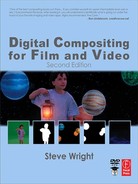Preface
This book is about hands-on digital compositing techniques in the quest for photo-realism in feature film and video digital effects. Of course, artistic training is an essential ingredient to achieving photo-realism because it is in the art class that you learn how things are supposed to look. But the other requirement is mastery of your tools and the technology. Knowing what the picture should look like will do little good if you can't bend the images to your vision. Reading the owner's manual will teach you how to operate your compositing software, but it will not teach you how to pull a good matte from a badly lit bluescreen or what to do when banding erupts in a digital matte painting. It is the difference between the owner's manual for a car and driving school. The first teaches you where the knobs are, and the second teaches you how to use them to actually get somewhere.
Although very suitable for beginners, this is not an introductory book. It assumes that the reader already knows how to operate the compositing software, what a pixel is, and what RGB means. It is intended for the digital artist sitting in front of a workstation with a picture on the monitor, wondering why there are edge artifacts in a bluescreen composite and how to get rid of them. The attempt was to present the topics with sufficient background detail that they will be of value to the beginner while including advanced concepts and production techniques that will also be of interest to the senior compositor.
This is also a “software independent” book. It carefully avoids the specifics of any particular brand of software and uses procedures and operations that are common to all software products, such as add, maximum, and color curves. You will be able to perform all of the procedures in this book regardless of the brand of software you are using, including Adobe Photoshop. I like to think of Photoshop as a single-frame compositing package with extended paint capability. Adobe Photoshop has become an important tool for previsualizing digital effects shots, so it would be very useful to know how to use it to pull a color difference matte and perform the despill for a bluescreen shot.
Each topic has two thrusts. The first is understanding how things work. It is much more difficult to solve a problem when you don't know what is causing it, and a big part of the time spent in production is in problem solving. There is a great deal of information on how different matte extraction methods work, how despill works, and what goes on inside a compositing node. The purpose of all this information is to provide a sufficient understanding of the issues that conspire to spoil your fine work so that when you encounter a production problem you will be able to stab your finger in the air and declare, “I know what's wrong here!”, then turn around and fix it straight away.
The second thrust is production technique: how to help your keyer pull a better bluescreen matte, how to create a more photo-realistic depth of field effect, and when to use a “screen” operation instead of a composite, to cite but a few examples. The different film formats are not simply listed in a table, but described in terms of the client's artistic intent in filmmaking, how to work with them, and how to combine images from two different formats. There are also several step-by-step procedures for accomplishing particular effects. A great deal of effort was put into alerting you to the potential problems likely to be encountered when working with less than perfect real-world elements, and providing suggested solutions and work-arounds.
While the information and techniques described herein apply equally to film and video work, the focus of the book's presentation is feature film, simply because it is the most demanding application of digital effects. The much greater resolution and dynamic range of film make it more challenging to achieve satisfactory results, so it is the “gold standard.” Video is, of course, extremely important, so it gets its own special chapter. As a result, the issues unique to video, such as the effects of interlaced scanning and non-square pixels, are collected together in one chapter to avoid muddling the general discussion of digital effects.
By virtue of gaining a deeper understanding of how things work, my hopes for the reader of this book are threefold: that you will not only finish your shots faster, but that they will also look better, and that you will have more fun in the process. Let's face it. What could be more rewarding than putting together a beautiful shot to be admired by millions of viewers? Enjoy.
